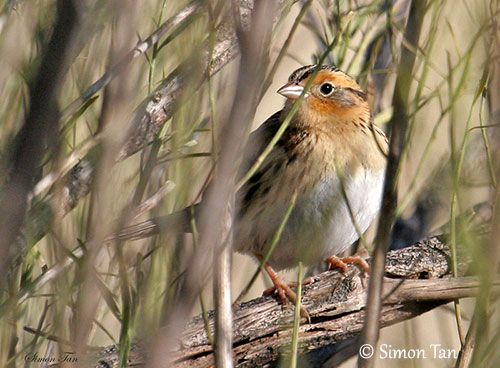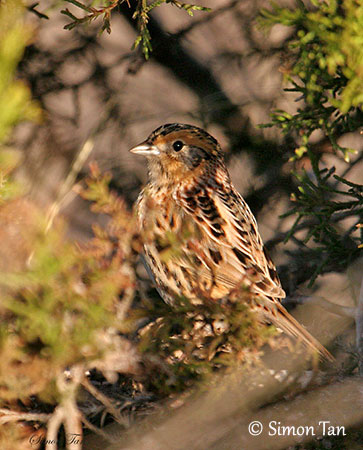
Fr: Bruant de LeConte
Ang: LeConte's Sparrow
All: Leconteammer
Esp: Chingolo de Leconte
Ita: Passero di Le Conte
Nd: LeContes Gors
Sd: LeContes sparv
Photographer:
Simon Tan
PBase Bird galleries
Text by Nicole Bouglouan
Sources:
HANDBOOK OF THE BIRDS OF THE WORLD Vol 16 by Josep del Hoyo- Andrew Elliot-David Christie – Lynx Edicions – ISBN: 9788496553781
A GUIDE TO THE BIRDS OF MEXICO AND NORTHERN CENTRAL AMERICA by Steve N. G. Howell, Sophie Webb - Oxford University Press - ISBN: 0198540124
FIELD GUIDE TO THE BIRDS OF NORTH AMERICA - National Geographic Society - ISBN: 0792274512
BIRDS OF THE GREAT BASIN – by Fred A. Ryser - Univ of Nevada Pr -ISBN: 0874170796
Houston Audubon Society (National Audubon Society)
South Dakota Birds and Birding – (Terry L. Sohl)
Wikipedia, the free encyclopaedia
LeConte's Sparrow
Ammospiza leconteii
Passeriformes Order – Passerellidae Family
INTRODUCTION:
The LeConte's Sparrow is a North American species which breeds in C and S Canada and extreme NC United States. It winters in SE United States.
It is usually found in wet grassy fields, prairies and marsh edges, both in breeding and non-breeding periods. It feeds on seeds of grasses and weeds, but during summer, it primarily feeds on arthropods.
The nest built by the female is a cup-shaped structure placed on or close to the ground. The female performs alone most of the nesting duties, but the male may help to feed the chicks.
The LeConte's Sparrow was first described in 1790 by John Latham, but the species was named by John James Audubon in 1844. The bird’s name pays tribute to John Lawrence LeConte, a young physician and naturalist. However, there were several LeConte in the 1800s who were also active naturalists, involving several conflicting advises.
The LeConte's Sparrow is declining slowly, but the population trend is stabilising and currently, the species is not globally threatened.

DESCRIPTION OF THE BIRD:
Biometrics:
Length: 12-13 cm
Wingspan: 16-18 cm
Weight: 12-16 g
The LeConte's Sparrow is one of the smallest sparrows in North America.
The plumage is orange-buff overall, but especially on head and upper breast. The upperparts are heavily streaked black on back and wings. Both wings and short tail are dark brown with rufous and buff edges. The upperparts show cryptic pattern with blackish, brown, blue-grey and buff colours.
On the underparts, throat and breast are ochraceous-buff, becoming white on belly. Flanks and body sides are ochraceous with blackish streaks.
On the head, the face is buff with dusky cheeks and dark triangular postocular stripe. The crown is blackish-brown with a white median stripe. The wide supercilium is ochre as well neck sides and malar area. The nape is streaked rufous and blue-grey. Chin and throat are white.
The pointed bill is greyish-flesh with dark culmen.
The eyes are dark brown, surrounded by narrow, whitish eyering.
Legs and feet are pale pink to flesh.
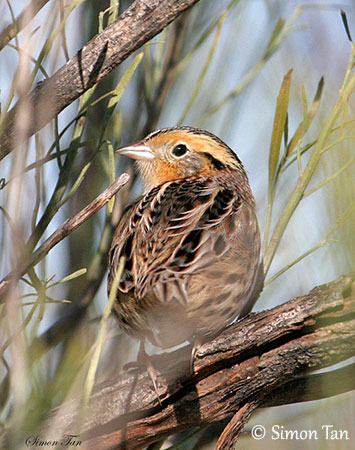
Male and female are similar.
The juvenile lacks the blue-grey areas on nape and upperparts. The buff nape is streaked dusky. The upperparts are stripped buff and blackish. Breast and flanks are streaked dark.
RANGE:
The LeConte's Sparrow breeds in C and S Canada and extreme NC United States. The breeding range extends from NE British Columbia, across Alberta, Saskatchewan and S Manitoba, as well in C Ontario and into Quebec. It also breeds far south in N Michigan, Montana and Minnesota.
The wintering areas are in SE United States, as far as W and C Texas and as far N as C Illinois and Missouri.
HABITAT:
The LeConte's Sparrow breeds in wet habitats such as wet meadows, edges of marshes and areas with damp ground, shallow water and dense grass, sedges or rushes.
When breeding in active cultivated areas, the species may nest in drainage ditches or dikes between wild rice paddies.
During winter, the LeConte's Sparrow occurs mainly in damp weedy fields, shallow freshwater marshes and coastal prairies, and especially in vegetation about 60 cm tall.
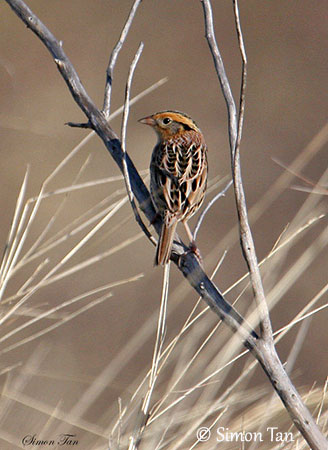
CALLS AND SONGS: SOUNDS BY XENO-CANTO
The LeConte's Sparrow is usually silent when flushed.
The common call is a sharp and shrill “tsip”.
The song is a short, high, simple song including 2-3 thin ‘chip” followed by a short trill. The song is described as an insect-like buzz. It lasts 1,25-1,30 second and can be rendered as a thin “r-r-t’-sz-z-z-t”.
A rare flight song is described as an aerial trill “eélree-eélree-eélree-eélree” while the bird is balancing in the air, 3-4 metres above the ground.
BEHAVIOUR IN THE WILD:
The LeConte's Sparrow feeds on seeds, insects and other arthropods. Insects and arthropods are mainly taken during the breeding season.
The bird forages on the ground, searching for grasshoppers, leaf-beetles, leafhoppers, stinkbugs, weevils, caterpillars, moths and spiders.
During winter, it consumes mainly seeds of grasses and weeds of various species.
The LeConte's Sparrow is very secretive and spends most of its time under the vegetal cover, especially tall grasses. It is usually difficult to flush and prefers to run across the ground. When flushed, it may fly at 1-3 metres but it often prefers to fly 60-100 cm above the grass before to descend again within a few metres.
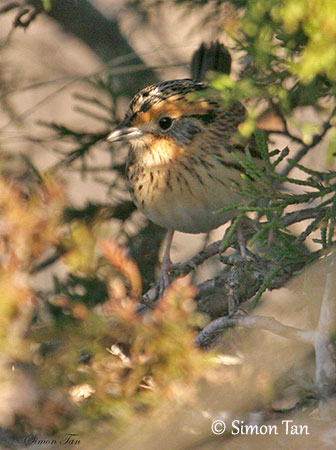
During the breeding season, the male sings from a perch to defend the territory. It may sing by day or night, perched within the tall grass.
The nesting behaviour of this species is poorly known, because the nests are usually well hidden and very difficult to find. The nest is generally built very close or on the ground.
The species is apparently monogamous, but more study is required.
About the courtship behaviour, only a flight song is reported, used to establish and maintain the territory.
The LeConte's Sparrow is migratory. It moves relatively late in autumn and in early spring. The peak of passage is during October, March and April in many areas.
This specie is a short-distance migrant and moves usually by night, single or widely spaced. The birds leave the breeding range in September, whereas the spring migration takes place in March to April.
The LeConte's Sparrow often moves more like a mouse than a bird. When alarmed, it runs quickly over 1-3 metres rather than fly away from danger.
While migrating, the flight is often direct or slightly undulating.
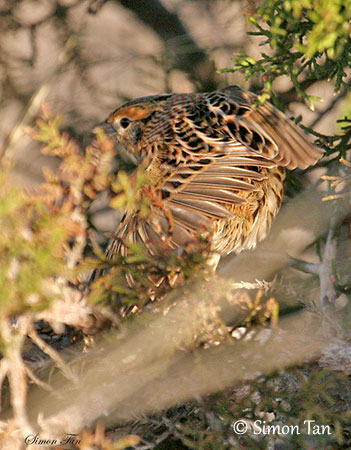
REPRODUCTION OF THIS SPECIES:
The breeding season takes place from April-May to September. The first clutch often occurs in late May to mid-June.
The nest-site is usually very close or on the ground. It is well hidden among dead grass, rushes or sedges, remaining from preceding seasons.
The nest is an open cup made of grass and rushes. The cup is lined with finer grass, and occasionally with animal hair. This structure is attached to standing stems. It is probably built by the female alone.
She lays 3-5 (usually 4) greyish-white eggs with brown and grey spots. She incubates alone during about 12-13 days. At hatching, the chicks are helpless with sparse brown down. They are fed by the female, but the male may help after a short period of time. No more information.
PROTECTION / THREATS / STATUS:
The LeConte's Sparrow is threatened by degradation of the habitat, caused by periodic disturbances like fire or haying that are necessary to clean some areas.
The numbers have also declined in some regions because the damp fields have been converted to farmland.
The global population is estimated to number 5,100,000 mature individuals. This population is declining at an average rate of 2,2% per year between 1970 and 2017.
However, the population is possibly becoming stable and the species is not globally threatened at the moment.
The LeConte's Sparrow is currently evaluated as Least Concern.
